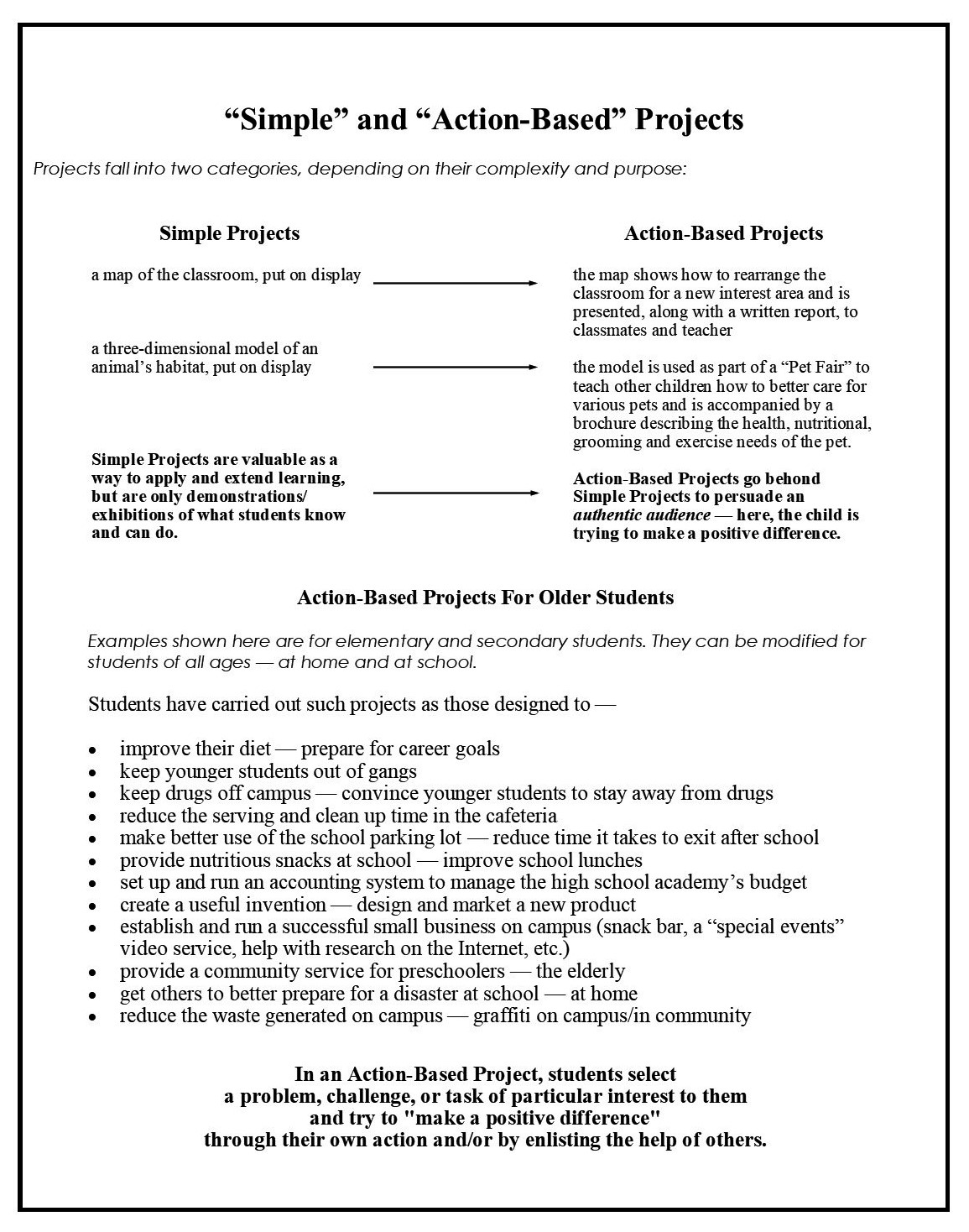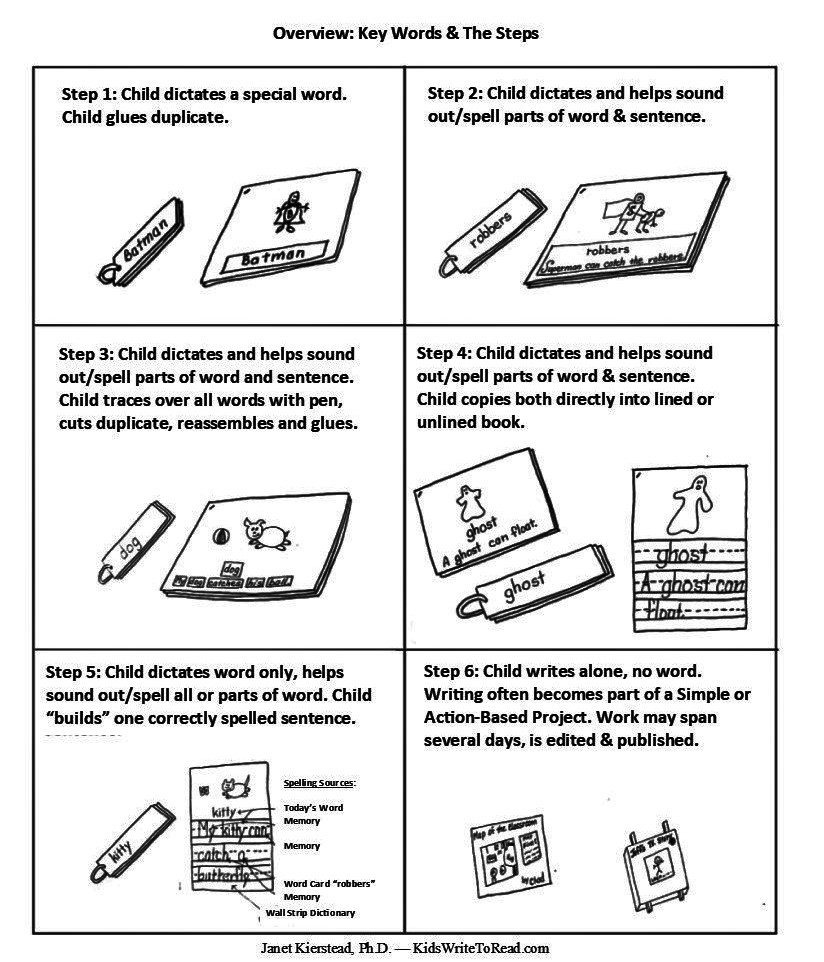The basic premise
A child is born with a strong urge to communicate what’s on their mind. Their natural progression is Body Language/Crying –> Speech –> Writing –> Reading the Thoughts Of Others.
So in addition to reading early and often to the child, we also help them develop literacy skills through writing. And the best way to begin with that is by showing them how their own “talk” looks, written down. In doing this, we are creating a bridge that connects the child’s own thoughts and speech to print. And for some, this is the first time they realize that print has meaning.
We do this with a strategy known as Key Words. These are the captions for a child’s “mind pictures.” Seeing their own Key Words printed for them captures their interest and imagination. So this makes these words a powerful magnet for skill development.
Repeatedly watching their own words being written — and later writing them on their own, within complete sentences — the child absorbs and develops all the skills that go into reading.
Thus with Key Words, we aren’t directly “teaching” reading and writing in the traditional way. Instead, we’re attaching literacy skills to what the child already knows and is especially interested in. That is, we are emphasizing and building upon words with strong meaning for the child. This mirrors the process adults spontaneously use as a child is beginning to talk.*
So with this, the child learns to read and write with the same pleasure and ease as they learned to speak.
Phonics is incorporated into Key Words
The child is not asked to memorize phonics — the sound/symbol relationship — as if it were like the multiplication table. Instead, they develop skill with phonics -in two ways. And these are done in different settings:
1) They first engage in phonemic awareness activities, where they begin to notice the sounds they’re making as they speak. In the classroom, this is done in a group setting.
2) Then while sitting alone, with a parent (or in the classroom, the teacher, an aide, or cross-age tutor), they begin to use that awareness to make connections between the sounds and letters as they dictate their Key Words. This begins as the child watches someone write their Key Words. Then later, as the child is writing independently, they use and further develop a sound base of phonics while spelling.
To Begin: Using Key Words
 To capture a child’s first Key Word, we have them talk about something important to them. This might be something they love, fear, want, or are simply fascinated with. As we write their word for them on a sturdy “word card,” we —
To capture a child’s first Key Word, we have them talk about something important to them. This might be something they love, fear, want, or are simply fascinated with. As we write their word for them on a sturdy “word card,” we —
- say the names/sounds of the letters,
- have the child trace each letter as we say them again.
- have them place their word on their “word ring,” and
- give them a duplicate of their word card to glue into their writing book and illustrate.
Once we write a Key Word for the child and they spend time illustrating it, they will remember it from then on. So they soon have a collection of words on their word ring that they will quickly read through every day. This not only gives them practice, but builds their confidence with print.
Increasing Complexity With The Steps
Then, as the child’s grows, getting a word becomes more complex. For we gradually move them through 6 increasingly complex follow-up activities, known as The Steps.
With this combined experience — Key Words and The Steps — they develop phonics/spelling skills, letter formation, punctuation, capitalization, and more. In doing this, the child is never working in isolation from meaning, but always for the purpose of communicating what’s on their mind. So they’re very interested in what they’re doing.
If we think back to when they were younger, we can see that this mirrors how they learned to speak. So it’s a way to capitalize on the child’s innate learning strategies. So again, we refer to all this as A Natural Approach.
Overview of The Steps: From Speech —> Writing —> reading what others write
As a child works their way through The Steps, they are constantly “reading back” what they’ve written. With this, they absorb sight words, as well as the other skills that go into reading. So by the time they reach Step 6, they have absorbed and developed all the requisite skills needed to read what others have written:
Beyond Key Words: developing process skills through simple and action-based projects
As the child approaches Step 6, we do two things: 1) We help them move into books written by others, and 2) begin showing them how to carry out independent projects, based on a topic of strong interest to them. These projects develop the process skills of research, analysis and reporting. Written project reports are accompanied by a product of the child’s own design. This might be a 3-dimensional object, timeline, diorama, chart — the possibilities are endless.
We make the distinction between two different types of projects:

Capitalizing on how a child learns naturally
In sum, by taking this “natural” approach, we have used the learning strategies a child is born with — the ability to absorb and the urge to copy what they see others doing in real-life situations of interest to the child.
With this, we have not been “teaching reading” just as we do not “teach” a child to speak. Instead, we have been helping a child learn to read, write, research, analyze, and report much as we help a child learn to speak — by “modeling,” within an authentic situation. The major difference here, is that Key Words, The Steps, and Projects allow us to be more systematic about it than we were with speech.
If you decide to experiment with this approach, please first take a few moments to consider why and how this works, by reading the following page: #1. Natural Approach: How and Why It Works. For this will help you make decisions for adapting these strategies to meet the needs of any child.
If you’re not already a member, you are welcome to join the Facebook group devoted to this approach, Helping ALL Kids Write To Read: https://www.facebook.com/groups/450288968924872/ There you will keep in touch with others experimenting with this approach and be notified of new descriptions/examples of this approach by the author.
________
*Studies have shown that adults do this naturally, using differences in intonation and cadence to emphasize special words. These findings have been replicated in a variety of countries. So it appears we are born with a natural tendency to help a child learn to speak by emphasizing words with significant meaning to the the child — in an authentic situation.
Further, in analyzing how a child learns to speak, we can see that the child has the ability to absorb new concepts and skills. So as we model certain words for the child learning to speak, we usually couch them in complete sentences. With this, we’re developing all the modifying and connecting words the child needs for full speech. So the “natural” approach used here also mirrors this, as we don’t have the child memorize sight words in isolation. Rather, the child absorbs/learns them by using them in their writing and later in reading back their own complete sentences.
Watching how adults spontaneously interact with a small child, it’s obvious that this is the set of innate skills — modeling, absorbing, and copying — that nature has provided for the child to learn to speak. Unfortunately though, the child’s ability to learn in this way is often overlooked when it comes to designing beginning reading programs.
Describing the strategies used in this more “natural” approach is an attempt to point out that nature has a better, easier way than the more traditional approach with which so many children struggle. But these are just one set of strategies that will work — see another example here.
